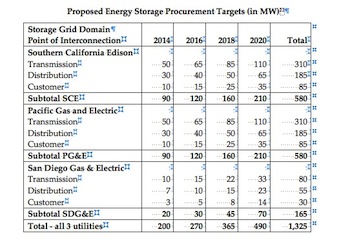Integrating energy storage into the grid is crucial to expand renewable energy and for the reliability of the grid.
California has been leading on that by requiring energy storage as part of utility-scale solar projects, and now the state is taking first steps toward establishing energy storage on the state’s grid.
In early September, the California Public Utilities Commission (CPUC) issued guidelines that will integrate 1.3 gigawatts of energy storage into the grid by 2020.
This long awaited announcement is a result of a law passed in 2010. AB 2514, widely viewed as landmark energy storage legislation, requires CPUC to establish specific targets for energy storage for 2015 and 2020.
In early September, CPUC issued guidelines which will do that -it is proposing that 1.325 gigawatts (GW) of grid-scale energy storage be integrated into California’s grid by 2020.
"This is the moment we’ve all been waiting for," says Janice Lin, Managing Partner of Strategen Consulting and Chair of this month’s Energy Storage North America Conference and Expo. "Commissioner Peterman’s historic proposed decision provides a critically-needed market signal to realize the many benefits energy storage can bring to California’s ratepayers. We’re certain that other states will follow California’s example."
Under CPUC’s proposal, the big three utilities get annual targets to meet for energy storage – they rise 30% – 55% every two years to keep momentum growing.
By 2020, they will have purchased 1.3 GW of energy storage, which they use to expand capacity, peak shaving, and other functions.
They have to buy at least half of that energy storage from outside sources, it can’t all come from their own renewable energy projects. And they have “consider all forms of resource ownership" (utility-owned, third-party owned, customer-owned, joint ownership), including entering into contracts with customer-sited storage resources.” This gives utilities lots of options from owning the resource to being able to incorporate storage on customers’ properties.
Utilities have to release their first energy storage solicitation by Dec. 1, 2014.
This chart shows utilities’ procurement targets:

Also, utilities can’t use pumped hydro storage projects of 50 megawatts (MW) or more to meet these targets. That forces them to make use of a variety of technologies, such as compressed-air energy storage, batteries, thermal energy storage and fuel cells.
Utilities can, however, count some existing projects toward the targets – they have to be operating for at least one year, be focused on grid optimization, integration of renewable energy or greenhouse gas emissions reduction.
PG&E is building a 300 MW power plant where wind energy will be used to store compressed-air in a cavern underground for use during peak demand. Southern California Edison has an 8 MW, lithium-ion battery for wind farms.
Besides the "big 3" utilities, the law applies to all "electric service providers" and "community choice aggregators" – they must buy energy storage that’s at least equal to 1% of their annual peak load.
The worldwide market for wind power energy storage systems is expected to reach $1.1 billion by 2015 and $2.8 billion for solar by 2018, according to Lux Research. During the first half of this year alone, 633 energy storage projects are operating or under development worldwide.
Here are CPUC’s proposed guidelines:
